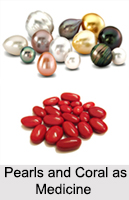 Pearls and coral have been used in medicine from a very ancient period and are mentioned by Sushruta.
Pearls and coral have been used in medicine from a very ancient period and are mentioned by Sushruta.
Processing of Pearls and Coral
Pearls are purified by being boiled in the juice of the leaves of Sesbania aculeata (jayanti), or of the flowers of Agati grandiflora (vaka). Coral is purified by being boiled in a decoction of the three myrobalans. Both are prepared for medicinal use by being calcined in covered crucibles and then reduced to powder.
Benefits of Pearls and Coral
The properties of both these articles are said to be alike and they are generally used in combination. They are said to be useful in urinary diseases, consumption etc., and to increase the strength, nutrition and energy of weak persons.
Dose of Pearls and Coral in Medicine
The following are examples of prescriptions containing pearls and coral.
Pittantaka Rasa: Take nutmegs, mace, Jatamansi root, root of Aplotaxis auriculata (kushtha), leaves of Pinus Webbiana (talisapatra), aconite, iron pyrites, iron, talc and realgar, one part each, prepared pearls equal in quantity to all the above ingredients. Beat them together into a paste with the aid of water and make into 4 grain pills. This medicine is said to be useful in diseases supposed to be caused by deranged bile, such as dyspepsia, jaundice, biliousness, vomiting of bile, etc.
Vasanta Kusumakara Rasa: Take prepared gold and camphor, each 2 parts, prepared tin, lead and iron, 3 parts each, prepared talc, pearls and coral, four 4 parts each. Rub these ingredients together in a mortar and soak the powder 7 times successively in each of the following fluids, namely, milk, sugarcane juice, juice of Adhatoda Vasica (vasaka), decoction of lac and of Pavonia Odorata (bala), juice of the flowers and root-stock of the plantain tree, of the root-stock of Nelumbium Speciosum (lotus) and of the flowers of Aganosma caryophyllata (malatipuspa). Lastly soak in an infusion of musk prepared by macerating one part of musk in 8 parts of warm water for 12 hours. Divide this mass into 4 grain pills. They are given with sugar, honey and ghee in urinary diseases, impotence, gleet, diabetes, consumption and general debility. This medicine is regarded as a valuable alterative tonic in chronic gonorrhoea and spermatorrhoea and is much prescribed in these complaints in combination with an extract called "Kusavaleha".




















